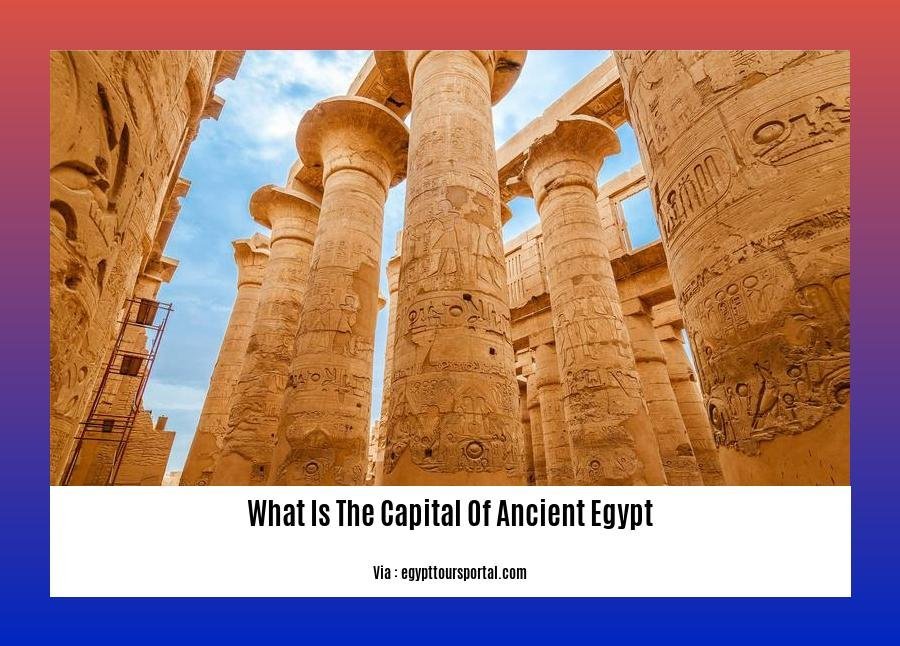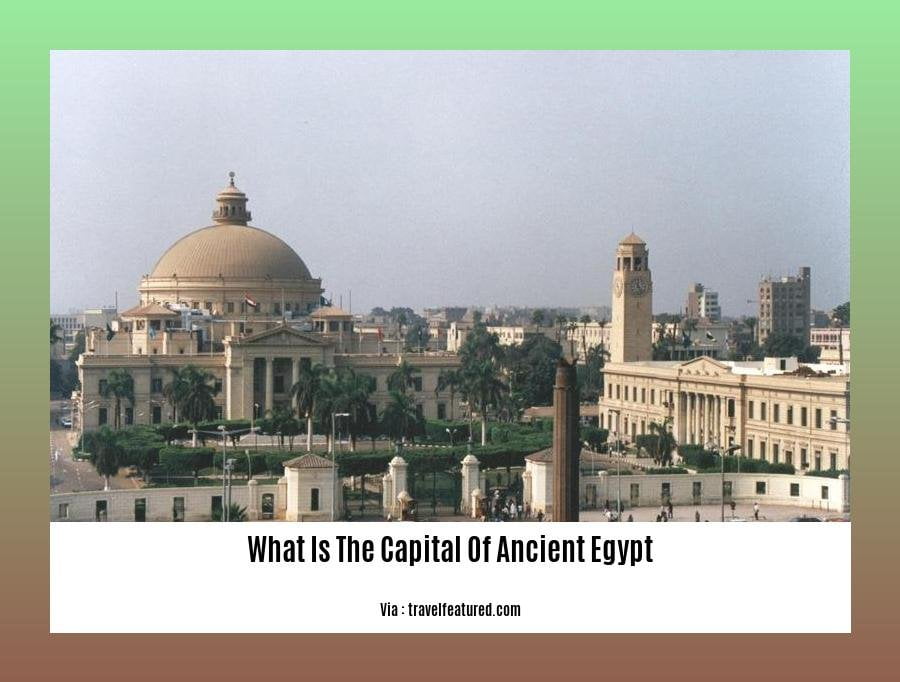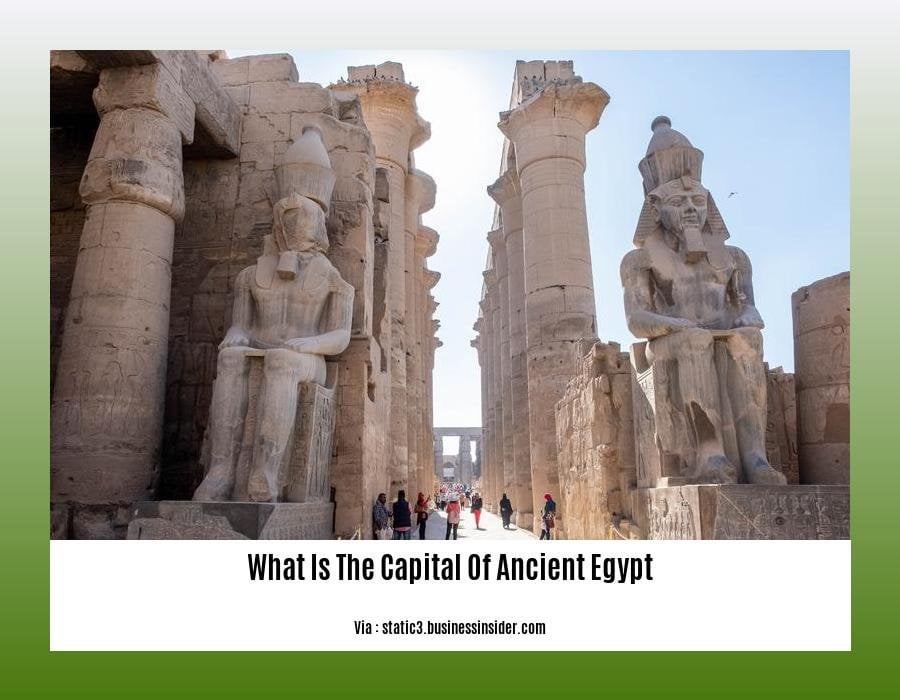When we envision ancient Egypt, with its majestic pyramids and enigmatic pharaohs, a common question arises: what city held the reins of power in those bygone eras? The answer, however, is far from simple, for the capital of ancient Egypt was not a static entity but rather a title passed from one grand city to another throughout its storied history.

What Is the Capital of Ancient Egypt?
The ancient Egyptians didn’t have a single capital city for their entire history. Instead, the capital shifted throughout different periods and dynasties. However, one city emerges as a strong contender for the title, particularly during the Old Kingdom, the era of pyramid building: Memphis.
Why Memphis? Its strategic location at the mouth of the Nile River Valley made it a pivotal connecting point between Upper and Lower Egypt. This strategic positioning transformed Memphis into a bustling hub of trade and commerce, attracting goods and merchants from far and wide, solidifying its economic and political dominance.
Beyond its economic prowess, Memphis held profound religious significance. The city was revered as the center of worship for Ptah, the god of creation, who was believed to have fashioned the world through his thoughts and words. Ptah’s temple, known as the “House of Ka,” likely attracted pilgrims from all corners of the ancient world, eager to pay homage to this powerful deity.
Even after the decline of the Old Kingdom, Memphis continued to thrive as a prominent city. Its magnificent temples, stunning architecture, and vibrant arts scene ensured its relevance and appeal. This enduring legacy persisted through the Hellenistic and Roman periods, a testament to Memphis’s lasting impact.
What is the real capital of Egypt?
While ancient Egypt saw numerous cities rise to prominence as capitals, today, the undisputed heart of Egypt is Cairo. Since its establishment in 969 CE, Cairo has reigned as the capital, its rich history interwoven with the ebb and flow of the Nile River.
Located strategically at the crossroads of ancient trade routes, Cairo has long been a melting pot of cultures and a center of intellectual and economic activity. Today, it stands as a modern metropolis, a vibrant hub of culture, education, and commerce, attracting people from across Egypt and the Middle East.
Was Thebes the Capital of Egypt?
Thebes, a city steeped in splendor and religious significance, also held the mantle of Egypt’s capital during two significant periods.
Thebes’s first rise to prominence occurred around the 11th dynasty, approximately 4,000 years ago. During this era, Thebes became a primary center of power, yet Memphis, the old capital, continued to maintain its influence, much like a revered elder statesman.
However, it was during the New Kingdom, around 3,500 years ago, that Thebes truly flourished. Known as the “City of the Was,” Thebes became the epicenter of religious life, home to awe-inspiring temples dedicated to the Theban Triad: Amun, Mut, and Khonsu. The remnants of Thebes’s grandeur can still be witnessed today in the awe-inspiring Valley of the Kings and the Valley of the Queens.
It’s crucial to remember that ancient Egypt’s political landscape was complex and multifaceted. Even when one city reigned supreme as the capital, other cities continued to play vital roles. Memphis, with its strategic location for trade and administration, remained crucial to the empire’s function.
Think of it this way: Thebes, during its reign, acted as the headquarters of a vast and intricate network, making high-level decisions and setting the overall direction. However, every successful enterprise needs multiple branches and departments to manage its diverse operations – that’s where cities like Memphis came in, ensuring the smooth functioning and interconnectedness of the Egyptian empire.
Thebes, therefore, was undoubtedly a capital of ancient Egypt, but its reign was not absolute or continuous. It exemplifies the ebb and flow of power throughout ancient Egyptian history, highlighting the dynamic nature of this ancient civilization.
Explore the ingenious tools used by the ancient Egyptians to construct their magnificent structures and craft exquisite artifacts.
Discover the unusual and intriguing weapons wielded by ancient Chinese warriors, providing a glimpse into their unique combat techniques.
Unravel the skilled craftsmen in ancient Egypt, delving into their techniques and contributions to the construction of timeless monuments.
Explore the intricate and diverse crafts practiced by ancient Egyptian artisans, from skilled craftsmen to meticulous scribes.

What was the capital of Upper Egypt?
Upper Egypt, the southern expanse stretching along the Nile River Valley, had its own center of power: Thebes. Emerging around 2130 BC, during the 11th dynasty, Thebes’s strategic location on the Nile’s west bank quickly established it as a significant center for trade and transportation.
What truly elevated Thebes to prominence was its association with a powerful triad of gods: Amun, Mut, and Khonsu. The presence of their main temples in Thebes transformed the city into a religious powerhouse, drawing pilgrims and devotees from across the land.
Thebes reached its zenith during the New Kingdom, between 1650 and 1070 BC. With an estimated population of 80,000, it was a bustling metropolis, renowned for its magnificent temples, including the iconic Karnak and Luxor, which stand today as testaments to Thebes’s architectural and religious significance.
While Thebes enjoyed a prolonged period as Upper Egypt’s most prominent capital, it’s important to acknowledge the fluidity of ancient Egypt’s political landscape. The role of a capital was not always as fixed as it is in modern times, and other cities undoubtedly held sway during specific periods. Nevertheless, Thebes’s legacy as a major hub of power, religion, and culture in Upper Egypt remains undisputed.
What was the ancient city of Egypt called?
Ancient Egypt boasted a tapestry of cities, each contributing to the grandeur of this ancient civilization. Among the most renowned was Memphis, founded around 2950 BC by King Menes.
Strategically positioned near the Nile River Delta, Memphis developed into a vibrant cultural and commercial hub. Its magnificent temples, including those dedicated to Ptah, the creator god, captivated the imagination, while the nearby pyramids of Giza stood as enduring symbols of ancient Egypt’s power and architectural genius.
As centuries passed, Thebes emerged as a prominent center of power, particularly during the Middle and New Kingdoms. Deeply entwined with the worship of Amun, a prominent deity in the ancient Egyptian pantheon, Thebes became synonymous with religious fervor and architectural splendor.
However, the story doesn’t end there. Alexandria, founded by Alexander the Great in 331 BCE, rose to become a beacon of knowledge and cultural exchange during the Ptolemaic dynasty, famed for its legendary library. Cairo, evolving over millennia, eventually became the enduring capital we know today.
Each of these cities played a pivotal role in shaping ancient Egypt’s identity, leaving behind a legacy etched in stone, papyrus, and the collective memory of humanity. Their stories, intertwined and ever-evolving, continue to fascinate and inspire, inviting us to delve deeper into the mysteries of this ancient civilization.
Did ancient Egypt have a capital?
The concept of a capital city in ancient Egypt differed significantly from modern notions. While today we associate a country with a single, permanent capital, ancient Egypt experienced a dynamic shift in its primary city, often reflecting the ebb and flow of power between different dynasties.
One of the earliest and arguably most iconic capitals was Memphis, established around 3100 BCE near the Nile River Delta. This bustling metropolis served as a political, economic, and cultural hub for centuries. Its legacy is most prominently etched in the awe-inspiring pyramids of Giza, a testament to the city’s power and architectural prowess.
As centuries passed and dynasties rose and fell, Thebes rose to prominence. During the Middle Kingdom, Thebes flourished, its magnificent temples and elaborately decorated tombs reflecting its status as a leading center of power.
Centuries later, Alexandria, founded by Alexander the Great in 331 BCE, ascended to become a pivotal city under the Ptolemaic dynasty. Known for its bustling trade routes and legendary library, a repository of knowledge unparalleled in the ancient world, Alexandria represented a shift in focus towards intellectual and cultural pursuits.
It’s important to note that our understanding of ancient Egypt is constantly evolving, with ongoing archaeological discoveries shedding new light on its complex history. Some experts suggest that other significant cities may have functioned as capitals during specific periods, further emphasizing the dynamic nature of ancient Egypt’s political landscape.
What is the Oldest Capital of Egypt?
The title of Egypt’s oldest capital belongs to Memphis, a city that sprung up on the west bank of the Nile River around 3000 B.C.E..
Established during the Old Kingdom after the unification of Upper and Lower Egypt, Memphis quickly rose to prominence, becoming the beating heart of this newly unified empire. It was the center of political power, religious worship, and cultural expression, laying the foundation for ancient Egypt’s future glory.
Memphis’s strategic location on the Nile River made it a hub for trade and commerce, connecting Egypt to the wider ancient world. This influx of goods and ideas contributed to the city’s wealth and cultural vibrancy, further cementing its position as a leading metropolis.
The ancient Egyptians took immense pride in their architectural achievements, and Memphis became a showcase for their skills. Massive monuments, adorned with intricate carvings, stood as testaments to their ingenuity, some surviving to this day, weathered but not broken by the passage of time.
The Colossus of Ramses II, a testament to the pharaoh’s power, and the Step Pyramid of Saqqara, one of the earliest pyramids ever constructed, are just two examples of Memphis’s architectural legacy. These structures, standing as postcards from a distant past, continue to inspire awe and wonder, reminding us of Memphis’s enduring impact as ancient Egypt’s first capital.
Does Egypt have two capitals?
While some countries have, at times, designated two capitals, Egypt’s story is far more intricate. It’s less about having two capitals simultaneously and more about a succession of cities claiming the title throughout its long and fascinating history.
The earliest known capital, Thinis, predates even the construction of the pyramids, highlighting Egypt’s ancient origins. Then came Memphis, a powerful city during the Old Kingdom, its legacy eternally entwined with the iconic pyramids and the enigmatic Sphinx.
As Egypt transitioned into the Middle Kingdom, Thebes rose to prominence. Determined to outshine its predecessors, Thebes boasted massive temples, elaborate tombs in the Valley of the Kings, and a grandeur that continues to captivate visitors to this day.
However, no empire lasts forever, and Thebes eventually relinquished its title. Alexander the Great’s conquest of Egypt ushered in a new era with the founding of Alexandria in 331 BCE. This cosmopolitan city, strategically positioned for trade, became a center of learning and intellectual exchange, home to the legendary Library of Alexandria
Finally, we arrive at Cairo. Established in the 7th century CE, Cairo strategically positioned on the Nile, proved resilient through centuries of change and upheaval. It eventually eclipsed its predecessors and claimed the mantle of Egypt’s capital, a title it retains to this day.
Egypt’s history is a tapestry woven from the threads of numerous cities, each taking its turn as the capital, each leaving an indelible mark on the nation’s identity. Their stories, intertwined and echoing through millennia, offer a glimpse into the dynamic and ever-evolving nature of this ancient land.
Is Cairo the capital of Egypt True or false?
It is true that Cairo is the capital of Egypt. Since its establishment in the 10th century, Cairo has served as the nation’s political, economic, and cultural heart.
However, Egypt’s history is a testament to the ebb and flow of power, with different cities claiming the title of capital throughout various periods. Before Cairo’s rise, Thinis, Memphis, Thebes, and Alexandria each held the mantle, leaving behind a rich tapestry of architectural wonders and historical significance.
Cairo’s strategic location on the banks of the Nile River, a vital artery for trade and transportation, solidified its position as a leading metropolis. When the Fatimids arrived in 969 CE, they recognized Cairo’s potential, and it soon flourished under their rule, becoming a center of Islamic culture and architecture.
While Cairo reigns supreme today, it’s crucial to remember its predecessors, each playing a vital role in shaping Egypt’s identity. Their stories, etched in stone and papyrus, invite us to explore the complexities of ancient Egyptian history, revealing a civilization constantly adapting and evolving.
Is it true that the Greek capital of Egypt was Cairo?
That’s a fascinating question that underscores the dynamic nature of cities and their evolution throughout history. While Cairo stands as a prominent symbol of Egypt today, it didn’t even exist during the peak of Greek influence in the region.
The Greeks, specifically the Ptolemaic dynasty, ruled Egypt from approximately 305 BC to 30 BC. During their reign, their chosen capital was not Cairo but Alexandria, a city founded by Alexander the Great himself.
Alexandria was a city ahead of its time—a bustling hub of trade, scholarship, and cultural exchange, attracting merchants, scholars, and travelers from across the ancient world. Its magnificent library stood as a beacon of knowledge, housing a vast collection of scrolls and attracting the brightest minds of the era.
Cairo, in contrast, emerged centuries later, becoming prominent long after Greek influence in Egypt had waned. The fact that different empires and dynasties chose distinct capitals reflects their priorities, ambitions, and the geopolitical realities of their time.
What is the original name of Cairo?
Cairo, a city steeped in history and crowned with a name synonymous with ancient grandeur, wasn’t always known by its current moniker.
When the Fatimids, a powerful dynasty that once held sway over vast territories, founded the city in 969 CE, they christened it Al-Mansuriyyah. This name, honoring the caliph Al-Mansur bi-Nasr Allah, a revered figure in Shia Islam, marked the city’s auspicious beginnings.
However, the Fatimids, driven by ambition and military prowess, soon expanded their realm, conquering Egypt and incorporating it into their burgeoning empire. To commemorate this momentous victory, they bestowed a new name upon their newly acquired capital: Al-Qahira.
Al-Qahira, meaning “The Victorious” in Arabic, aptly reflected the Fatimids’ triumph and their ambition to establish a city that embodied their power and prestige. Over time, this name, passed from tongue to tongue across empires and languages, transformed and evolved, eventually morphing into the Cairo we know today.
So, the next time you encounter the name Cairo, remember its fascinating journey through time, a journey that mirrors the city’s own transformation from a newly founded capital to a modern metropolis, its ancient heart still beating beneath its contemporary facade.



![A Journey Through Time: Exploring Ancient Egypt's Remarkable 31 Dynasties [ancient egypt history is divided into 31] ancient-egypt-history-is-divided-into-31_2](https://www.lolaapp.com/wp-content/uploads/2023/12/ancient-egypt-history-is-divided-into-31_2-150x150.jpg)








